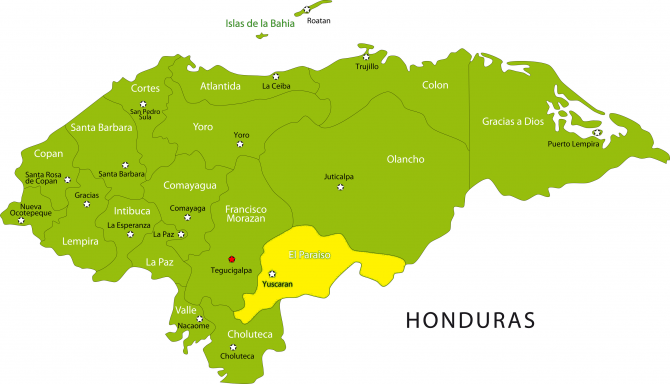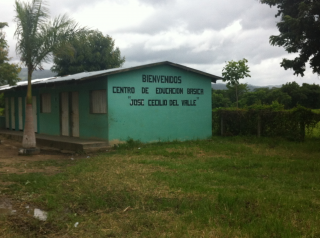Cuyali, Honduras
![]()
![]()
![]()
![]()
![]()
![]()
![]() Click on Programs to learn more about their work in this community
Click on Programs to learn more about their work in this community
General Information

| Population* | 1752 |
| Number of homes | 369 |
| Avg # of people per home | 4.7 |
| Number and % of children |
(0-5): (0-9): |
| Electricity | Yes |
| GPS |
N 13° 53.577’ W 086° 32.686’ |
| Altitude | 2523 ft |
| Municipality | El Paraíso |
| Department | El Paraíso |
| Corresponding Health Center | CESAMO-El Paraíso |
| Distance from compounds | 1 hour 20 minutes |
| Road conditions | Good |
* Population does not reflect how many patients will be seen on medical
brigades as many people from surrounding communities come seeking
Medical Brigades medical attention.
Top Three Needs Expressed
The top three needs expressed by the key community members are sufficient quantity of water, a waste management system, and electricity for certain sectors of the community not reached.

Cuyali is located in the El Paraíso municipality of the El Paraíso department.
Cuyali’s educational system includes Kinder, Primary, and Middle schools (until 9th grade). There are 410 students at the schools and Tomas Zepeda is the school director. It is approximated that about 95% of the community knows how to read and write.
Cuyali has a water system that was first constructed in 1987 by the community’s own Asociación Padres de Familia (Parents Association) and it is a perforated electric well system. The main problem with the system is that water only arrives every other day for an hour at a time. Also, the water is chlorinated once every 2 weeks. 1 100% of homes in Cuyali are connected to the system. There is a Water Council with 5 active members and Pedro Ortis is the president.
Cuyali does not have a health center in the community. The nearest health center is in El Paraiso, about a 1-hour walking distance, though some people can find personal transport since the community is relatively close to the highway. There is no basic sanitation committee, though there used to be in the past with 2 active members. Dental care is not available in the community, though it is at the health center in El Paraiso.
The most common illnesses seen by community members are flu, diarrhea, and dengue. Approximately 50% of the community is estimated to have latrines that currently function. 0% has eco-stoves (estufas justas). About 94% is estimated to have cement floors and 50% to have pilas (water storage units).
II. Caserios (small villages) served by CESAMO-El Paraiso, 2009
|
Caserios |
Population |
Number of Homes |
Potable Water (%) |
Latrines (%) |
Malnourished Children |
Births/ % Coverage of Pregnancies |
Order of Priority (based on HC standards) |
|
El Paraiso serves over 29 neighborhoosds in the town of El Paraiso as well as |
|||||||
|
Cuyali |
1752 |
369 |
95 |
80 |
1 |
45 / 85% |
9 |
Centro de Salud Statistics, Centro de Salud—Danli, 16 Marzo 2010
*Global Brigades also works in these communities with medical brigades.
The average family income per month is estimated to be 2000 Lempiras, which is approximately L400 (US $21.18) per person3. The majority of homes are made of adobe. The main form of employment is agriculture on rented land, and the main products that are cultivated in the community are corn and beans. Members of Cuyali have access to credit from BANADESA, an agricultural loan agency for land owners. They do not have a community bank, though they would be interested in forming one.
Cuyali is not currently receiving medical brigades from any organization other than Global Brigades. Years ago, the local municipality constructed latrines but a lot are now no longer usable. In 2009, the literacy program Yo Si Puedo also worked to improve adult literacy.
Cuyali is a larger town that is located relatively close to the highway. Our relationship with the community has mostly been through the Catholic Church members; however, collaboration with other community members has begun to form. Several key leaders, like the school director, do not live in Cuyali since it is located a reasonable, commutable distance from larger cities like El Paraiso where there are more resources.
 |
 |
Source of information: Key informant interview, Centro de Salud statistics
Date of interview: 13 May 2010
1The accepted regulation frequency for chlorinating water is every 4 days.
2CESAMO and CESAR are terms used for types of health centers. CESAMOs are larger, more comprehensive facilities that usually have a physician on staff at all times and occasionally a dentist. CESARs are more remote, less equipped facilities, usually with 1-2 nurses on staff.
3According to Red Solidaria and World Food Programme in Honduras, the average family is approximated at 5 people per household, the poverty line is L930 (US$49.23) per person per month, and the extreme poverty line is L617 (US$32.66) per person per month.